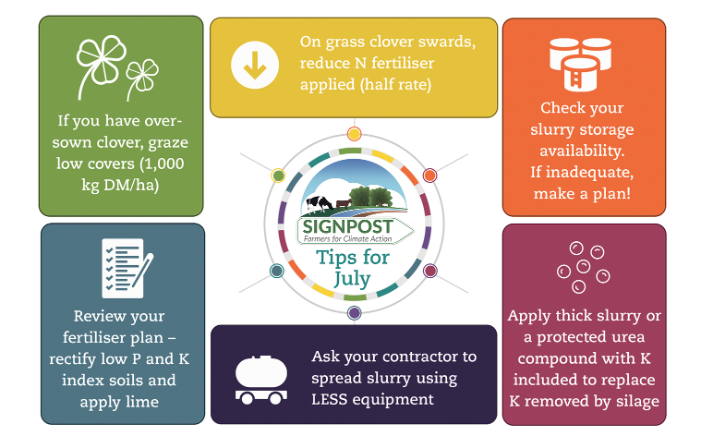12 July 2021
Climate Actions for July
For the latest current and up to date farm advice from the Signpost Programme and for details of the Climate Actions that you should adopt for the month of July on your farm see here

Oversown Clover Swards
Graze swards that have been over sown at 800 kg DM/ha on the first grazing. At 1100 for the following three grazing rotations, with a post-grazing sward height of < 4 cm. Avoid building high pre-grazing covers of these swards for the remainder of the year. Close later in the final grazing rotation, as this allows light to the base of the sward. This is essential for the clover plant to establish and persist. Nitrogen fertiliser can be reduced for the first 2 applications after over-sowing to aid the clover plant become established. For the remainder of the year, normal fertiliser rates should be applied, as the clover plant required nitrogen to help in plant development. Once these swards are 12 months old, and there is adequate clover content (20-25%), nitrogen fertiliser can be reduced.
Reduce N Fertiliser
For existing white clover swards reduce application rate of fertiliser over the summer to promote clover establishment.
Nitrogen fertiliser application strategy
Have adequate slurry storage
Having adequate slurry storage and including a buffer offers many advantages including:
- More flexibility to match slurry application timings with grass growth.
- Better use of nutrients when grass is growing.
- To better manage increased rainfall events at the shoulders of the year.
- To provide cover for miscellaneous issues where water enters tanks and reduces capacity.
- To have enough storage to meet the regulations and a buffer of 20% to cover miscellaneous occurrences.
- To use slurry to replace one round of chemical fertiliser/year.
- To apply slurry at the correct time to maximise the fertiliser replacement value (N, P and K) of slurry.
- To take advantage of the TAMS grants available to farmers for additional slurry storage of 40-60%. The cost can also be written off against tax and the VAT is reclaimable. More details on slurry storage Slurry storage – have you enough? (PDF)
Restore nutrients after silage
A typical bale of silage weighing 800kg fresh (200kg dry matter) contains 10 units of nitrogen (N), 1.6 units of phosphorus (P) and 10 units of potash (K). For example where surplus bales are removed, four to five bales of silage per acre will remove six to eight units of P/ac and 40 to 50 units of K/ac. Apply thick slurry and protected urea compound (includes K) to restore nutrients, in particular K.
Use LESS equipment to spread slurry
Farmers should use slurry as the number one source of nutrients on the farm. Spreading slurry by LESS will increase the availability of nutrients and reduce gaseous emissions. LESS retains an extra 3 units of N / 1,000 gallons of cattle slurry. Most contractors have both the traditional splash plate and LESS equipment, its up to farmers to ask their contractor to use LESS.
Review your fertiliser plan
It’s a good time of the year to review your fertiliser plan. Too often these plans are used for regulation purpose rather than helping improve soil fertility on the farm. Take a look at the liming map, the P map and the K map to identify fields that need some extra work.
Signpost Newsletter Subscription
Subscribe to our newsletter and stay updated on what The Signpost Programme is doing to lead climate action by Irish farmers and their transition towards more sustainable farming systems
Find out all about the Signpost Programme here

